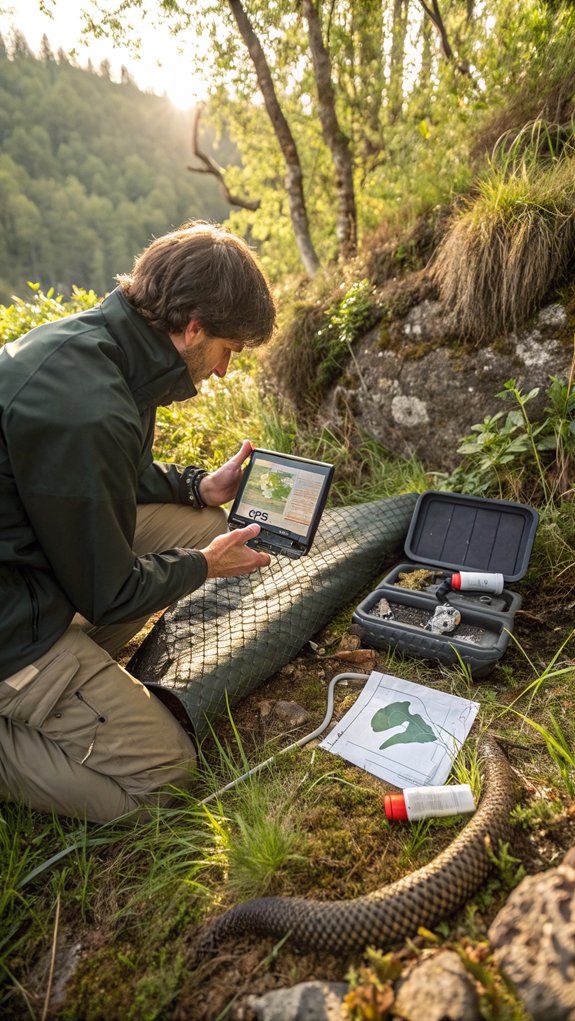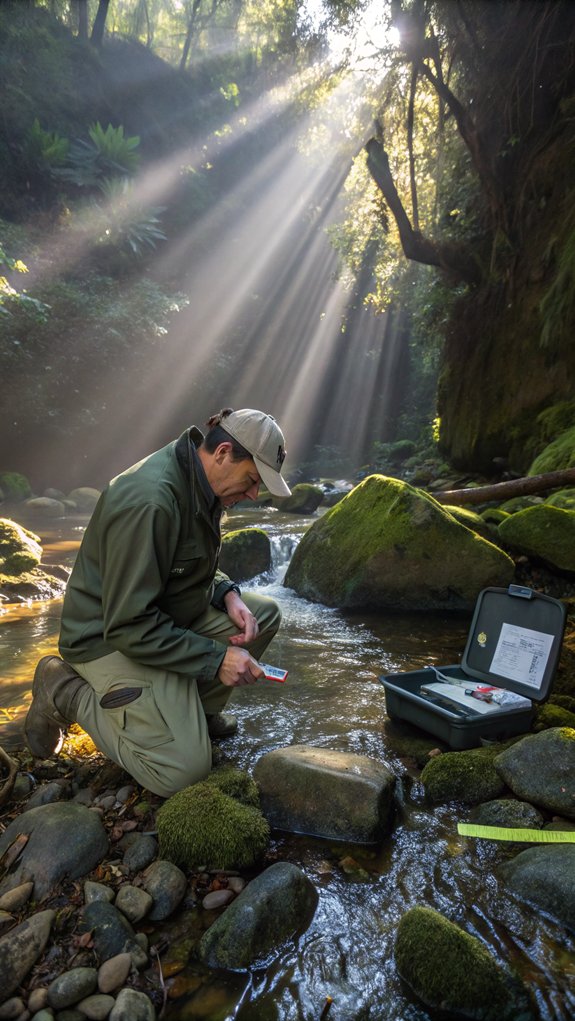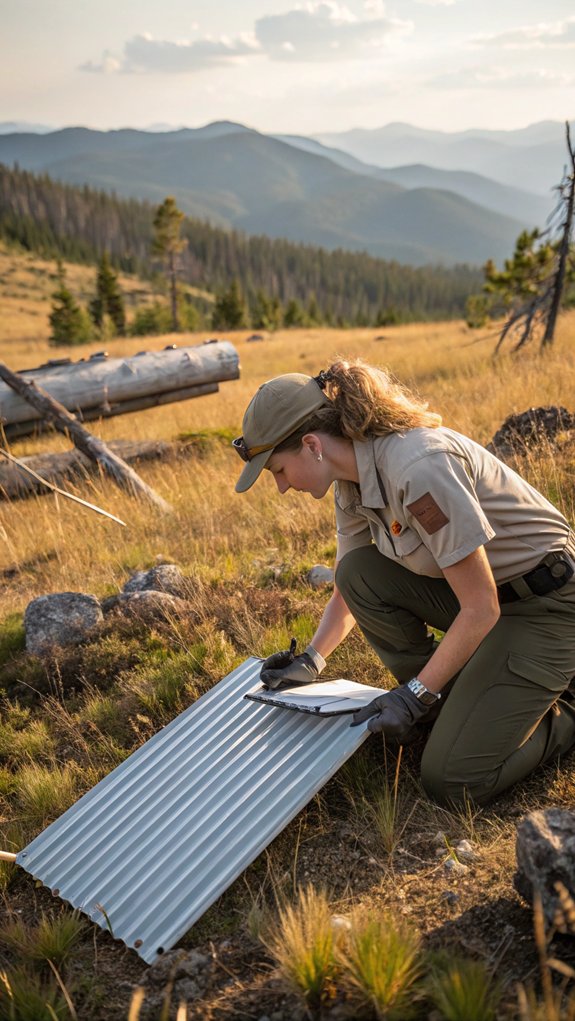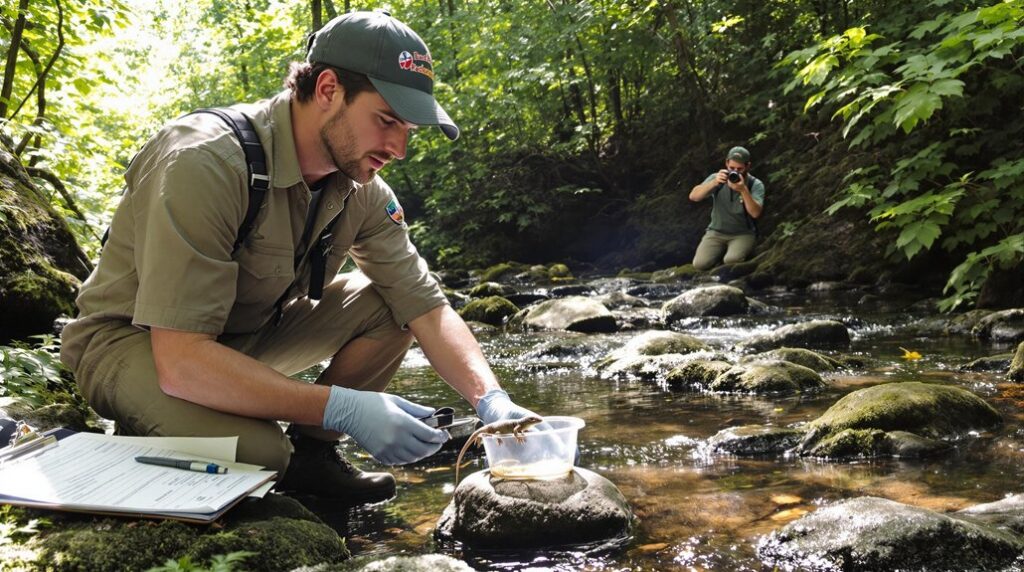Reptile surveys require planning between March and October when temperatures reach 15-25°C. You’ll need artificial refuges like felt squares and corrugated sheets placed in ideal habitats such as grasslands and woodland edges. Survey during early morning or late afternoon when reptiles bask, avoiding rain and strong winds. Licensed professionals must conduct surveys to comply with wildlife protection laws. Proper execution guarantees accurate species identification and fulfills legal requirements for development projects.
Planning Your Reptile Survey Objectives

Before commencing a reptile survey, you’ll need to establish clear objectives that satisfy both scientific and regulatory requirements. Start by confirming your obligations under local wildlife laws and protected species regulations to avoid potential fines for habitat disruption.
Your survey should be designed to detect presence/absence of reptiles with high confidence while estimating minimum population size and distribution. Focus on evaluating habitat suitability across various environments including grasslands, heath, and brownfield sites.
Align your objectives with conservation priorities for threatened species and integrate appropriate biodiversity assessment methodologies.
Your data will ultimately guide mitigation measures, so plan to collect information that can inform habitat preservation zones and species credit calculations.
Remember to structure your survey to minimize false negatives through systematic design, as this will be vital for developing effective relocation plans and habitat compensation strategies later in your project.
Essential Equipment and Field Materials
Once you’ve established your survey objectives, you’ll need to gather the right tools for the job.
Start with artificial refuges: corrugated reptile refugia, felt squares, or carpet tiles provide shelter and basking spots that attract reptiles. For handling, invest in snake hooks (100-130cm) and tongs (91-120cm), plus HexArmor guards if venomous species are present.
Measurement tools are essential: Pesola spring scales for weighing specimens, tape measures for size documentation, and waterproof notebooks for recording data. Our department provides a variety of precision scales and balances for accurately weighing reptile specimens in the field.
Consider using the Dragon Finder App to submit sightings digitally.
For effective detection, pack torches for illuminating refuges, amphibian nets for difficult terrain, and camera traps to monitor without disturbance.
If you’re surveying protected species like sand lizards or smooth snakes, carry your licensing documents.
Always check weather conditions before heading out—surveys are most productive between 8-18°C on sunny days.
Selecting Optimal Survey Locations and Habitats

Choosing the right locations considerably increases your chances of encountering reptiles during surveys. Focus on open grasslands, south-facing chalk downland, woodland edges, and even brownfield sites where reptiles can thermoregulate effectively.
Target specific microhabitats within these areas. Examine south-facing embankments, log piles, stone walls, and shifting zones between different habitat types. These edges—particularly woodland/grassland boundaries and wetland interfaces—create ideal conditions for various reptile species. The most productive survey sites are often found in transitional zones between different habitats.
Pay special attention to topography. South-facing slopes with well-drained soils offer maximum solar exposure, while elevated features provide vantage points. Don’t overlook artificial structures like railway verges and managed but untamed private gardens.
For seasonal success, search damp microhabitats during cooler months for grass snakes and adders. Remember that different species prefer different conditions—grass snakes favor wetland proximities, while common lizards thrive along scrubby margins.
Reptile Survey Timing and Weather Considerations
Successful reptile surveys depend heavily on timing and weather conditions that align with reptile behavior patterns.
Plan your surveys between March and October when reptiles are most active, as they typically hibernate during colder months.
Focus your efforts during early morning and late afternoon when many species emerge to bask in the sun while avoiding midday heat. Temperature considerably affects reptile activity—conduct surveys when ambient temperatures range between 15-25°C (59-77°F), as reptiles are less likely to be visible in cold or extremely hot conditions.
Avoid surveying during heavy rain, strong winds, or overcast days when reptiles typically remain hidden. Instead, target days following light rainfall when humidity is higher, especially for amphibious reptiles.
Spring and early summer are particularly productive periods as many species engage in breeding activities and territorial displays, making them more conspicuous and easier to document during your survey efforts. Specifically, April and May are considered optimal months for reptile surveys as activity levels peak during this time.
Proper Refugia Placement and Monitoring Techniques

Effective refugia placement forms the cornerstone of any thorough reptile survey, providing artificial shelters that attract species for easier identification and counting.
Position these shelters in “hotspots” like south-facing slopes and scrub edges, arranging them 2-5 meters apart in groups of up to 10 per hectare.
Use dark, heat-absorbent materials (felt or tin) sized 50x50cm to 100x50cm, placing them on short grass partially overgrown with vegetation.
Avoid high-disturbance areas and map each refugia with GPS for consistent tracking.
When monitoring, check refugia when surfaces feel warm but not hot—ideally after cold or rainy days.
Tilt edges vertically when lifting to avoid startling reptiles, using tools when necessary near adder habitats. Allow 2-4 weeks after deployment before your first check, and always replace refugia exactly as found, maintaining vegetation cover to preserve microhabitat conditions.
Species Identification and Data Recording Methods
Accurate species identification and meticulous data recording form the twin pillars of any successful reptile survey.
Learn to distinguish species by their visual characteristics – adders display a distinctive zigzag pattern, while grass snakes feature a characteristic stripe. Focus your searches on habitat edges and basking sites like logs and artificial refugia.
When recording observations, use standardized tools like the Dragon Finder App or forms that capture site conditions, habitat types, and precise grid references.
Remember to submit all surveys, even those without sightings, to increase data accuracy.
For identification, know key differences between venomous and non-venomous species. Common lizards have dewlaps while slow-worms don’t.
Document life stages accurately, noting morphological differences between juveniles and adults.
When encountering rare species like sand lizards or smooth snakes, remember you’ll need special licenses to conduct formal surveys for these protected reptiles.
Legal Requirements and Safety Protocols

While proper identification techniques form the foundation of reptile surveys, understanding the legal framework that governs them is equally important.
All six UK reptiles are protected under the Wildlife and Countryside Act 1981, with smooth snakes and sand lizards enjoying enhanced protection as European Protected Species.
You must guarantee surveys are conducted by licensed professionals—untrained handling is illegal and risks fines up to £5,000 or imprisonment.
Only deploy artificial refuges if you’re properly qualified. Survey timing is legally restricted to April through September to align with reptile activity cycles.
If your survey confirms reptile presence, you’re legally required to implement mitigation measures, such as habitat creation or species relocation.
Your final report must detail species density and developmental impact for local planning authorities.
Remember that specific habitats like heathlands and sand dunes receive additional protection under EPS legislation.
Effective reptile surveys should be conducted during sunny and warm weather conditions to maximize detection of basking individuals.
References
- https://arbtech.co.uk/protected-species/reptile-survey/
- https://www.froglife.org/wp-content/uploads/2013/06/Reptile-survey-booklet-3mm-bleed.pdf
- https://www.froglife.org/2022/02/28/a-beginners-guide-to-reptile-surveying/
- https://s3.amazonaws.com/lumenlearning/success/Master+PDFs/English-Composition-2_8-29-17.pdf
- https://www.wildcare.co.uk/media/wysiwyg/pdfs/froglife_advice_sheet_10_-_reptile_surveys.pdf
- https://luscinia-ecology.co.uk/reptile-surveys/
- https://www.ecologybydesign.co.uk/ecology-resources/what-is-a-reptile-survey
- https://www.environment.nsw.gov.au/-/media/OEH/Corporate-Site/Documents/Animals-and-plants/Biodiversity/threatened-reptiles-biodiversity-assessment-method-survey-guide-20220563.pdf
- https://www.nhbs.com/en/1/amphibian-reptile-survey
- https://www.nhbs.com/en/blog/nhbs-guide-to-reptile-survey-equipment

Erzsebet Frey (Eli Frey) is an ecologist and online entrepreneur with a Master of Science in Ecology from the University of Belgrade. Originally from Serbia, she has lived in Sri Lanka since 2017. Eli has worked internationally in countries like Oman, Brazil, Germany, and Sri Lanka. In 2018, she expanded into SEO and blogging, completing courses from UC Davis and Edinburgh. Eli has founded multiple websites focused on biology, ecology, environmental science, sustainable and simple living, and outdoor activities. She enjoys creating nature and simple living videos on YouTube and participates in speleology, diving, and hiking.
🌿 Explore the Wild Side!
Discover eBooks, guides, templates and stylish wildlife-themed T-shirts, notebooks, scrunchies, bandanas, and tote bags. Perfect for nature lovers and wildlife enthusiasts!
Visit My Shop →
